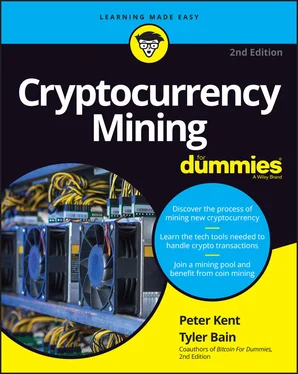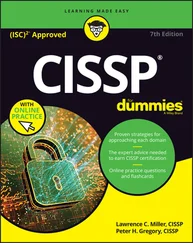Add a dash of David Chaum
In the mid-1990s, people were streaming online and for various reasons many didn’t want to, or couldn’t, use credit cards (see preceding section). Checks were even more difficult (unless you wanted to mail it), and cash was out of the question. (Though — and here’s a joke for the older geeks among you — I do recall a friend telling me to UUENCODE the $10 I owed him and email it to him. Again, this is Peter talking; I’m betting Tyler is too young to know what UUENCODE is.)
But back in 1983, a guy called David Chaum had written a paper called “Blind Signatures for Untraceable Transactions.” Chaum was a cryptographer (someone who works with cryptography) and professor of computer science. His paper described a way to use cryptography to create a digital-cash system that could enable anonymous transactions, just like cash. (Modern cryptography is the science of securing online communications; we’ll come back to this later.) In fact, Chaum is often referred to as the Father of Digital Currency as well as the Father of Online Anonymity.
Result? DigiCash, E-Gold, Millicent, CyberCash, and More
Bring together the Internet, complicated online transactions, a fear of using credit cards online, a desire for cash-like anonymous online transactions, and David Chaum’s work in the ’80s (see preceding section), and what do you end up with?
You get DigiCash, for a start, David Chaum’s 1990 digital-cash system. Unfortunately, Mr. Chaum seems to be early for the party too often, and DigiCash was out of business by 1998. There was also E-Gold, a digital cash system supposedly backed by gold, DEC’s Millicent (yes, yes, most of you are too young to remember DEC, too… . I’m starting to feel old writing this “historical” section), First Virtual, CyberCash, b-money, Hashcash, eCash, Bit Gold, Cybercoin, and many more. There was also Beenz, with $100 million in investment capital; Flooz, endorsed by Whoopi Goldberg (no, really!); Liberty Reserve (shut down after being accused of money laundering); and China’s QQ Coins.
With the exception of QQ Coins, still in use on Tencent’s QQ Messaging service, all these digital currencies are gone. Notably, many of these early digital currencies were in one way or another centralized with a trusted third-party intermediary.
Digital currency was not over, though. It got off to a rough start, with much trial and error, but plenty of people still thought that the world needed cash-like (in other words, anonymous) online transactions. A new era was about to begin: The cryptocurrency era.
The earlier digital currencies also depended on cryptography, it’s true, but they were never known as cryptocurrencies. It wasn’t until cryptocurrency was combined with a blockchain in 2008 that the term cryptocurrency started to gain usage, and the term really didn’t begin to appear widely until around 2012. (Blockchain? It’s a special form of database, but we’ll describe in more detail later in this chapter.)
In 2008 Satoshi Nakamoto published and posted in a cryptography forum known as the “Cypherpunk Mailing List” a document titled “Bitcoin: A Peer-to-Peer Electronic Cash System,” saying, “I’ve been working on a new electronic cash system that’s fully peer-to-peer, with no trusted third party,” he said.
The following list of attributes, Nakamoto stated, were key to Bitcoin:
Double-spending is prevented with a peer-to-peer network.
No mint or other trusted parties.
Participants can be anonymous.
New coins are made from Hashcash style proof of work.
The proof of work for new coin generation also powers the network to prevent double spending.
The document is a fairly dry read, but it’s worth spending a few minutes checking it out. You can easily find it by navigating to https://bitcoin.org/bitcoin.pdf . The abstract for the Bitcoin white paper begins with the following statement: “A purely peer-to-peer version of electronic cash would allow online payments to be sent directly from one party to another without going through a financial institution,” Nakamoto wrote. He explains that his method has solved the “double-spending” problem, an issue plaguing earlier digital currencies: the challenge was to make sure that a digital currency couldn’t be spent twice.
Nakamoto also describes using blockchain functionality, although the term blockchain appears nowhere in the white paper:
We propose … using a peer-to-peer network. The network timestamps transactions by hashing them into an ongoing chain of hash-based proof-of-work, forming a record that cannot be changed without redoing the proof-of-work.
Bitcoin: The first blockchain app
Early in January 2009, Nakamoto launched the Bitcoin network into action, using blockchain (a concept that had been around since the early 1990s, though this was the first time it had been correctly implemented), and created the first block in the blockchain, known as the genesis block.
This block contained 50 Bitcoin, as well as the text “The Times 03/Jan/2009 Chancellor on brink of second bailout for banks” as a justification and explanation as to why a system like Bitcoin was so important. Nakamoto continued coding updates into the protocol, running a node, and potentially mined around a million Bitcoin, a number that would make him one of the richest people in the world by the end of 2017 (at least “on paper”).
By the end of 2010, Satoshi Nakamoto published his last forum post and officially signed off from the project, but by this time many other cryptocurrency enthusiasts had joined in, began mining, supporting open source code development, and the rest is history.
Who (or what) is Satoshi Nakamoto?
So, who was this Satoshi Nakamoto guy … or gal … or organization? Nobody knows. Satoshi Nakamoto doesn’t seem to be a real name; it’s most likely a pseudonym. And if anyone knows for sure who Nakamoto really is, they’re not saying. It’s the great mystery of cryptocurrency.
There is a Japanese American man named Dorian Prentice Satoshi Nakamoto, born Satoshi Nakamoto apparently. This person was a trained physicist, systems engineer, and a computer engineer for financial companies — perhaps he was the Satoshi Nakamoto. However, he’s denied it several times.
How about Hal Finney, who lived just a few blocks from Dorian Prentice Satoshi Nakamoto’s home? He was a pre-Bitcoin cryptographer and one of the first people to use Bitcoin and claims to have communicated via email with the founder of Bitcoin. Some people have suggested he “borrowed” Satoshi Nakamoto’s name and used it as a pseudonym.
Then there’s Nick Szabo, who has long been involved in digital currency and even published a white paper on bit gold, before Nakamoto’s Bitcoin white paper. Or what about Craig White, who at one point claimed to be Nakamoto, but was later accused of fraud? Or Dr. Vili Lehdonvirta, a Finnish economic sociologist, or Michael Clear, an Irish graduate student in cryptography, or the three guys who filed a patent that included an obscure phrase (“computationally impractical to reverse”) also used in the Nakamoto Bitcoin white paper, or Japanese mathematician Shinichi Mochizuki, or Jed McCaleb, or some type of government agency, or some other kind of team of people, or Elon Musk, or, well, nobody knows, but theories abound.
The second biggest Bitcoin mystery? Nakamoto owned around a million Bitcoin, which in December 2017, was worth about 19 or 20 billion dollars. The entirety of Nakamoto’s estimated Bitcoin fortune has not been moved or spent; why hasn’t he touched this money?
Читать дальше












